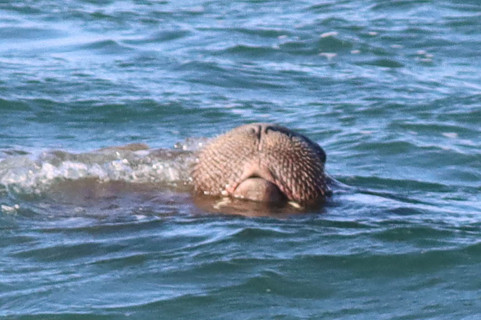Wally the Walrus at Tenby: a once-in-a-lifetime chance to appreciate such a majestic animal
- Roo
- Apr 11, 2021
- 3 min read
Last week we had a short three day break down in Pembrokeshire, and timed it nicely to miss Wally the Walrus who had been present at Tenby for over a week! It was still a lovely visit, with gorgeous coastal walks and we enjoyed watching common birds such as feeding Gannets, plus we were lucky enough to find a summer plumaged Spotted Redshank with a Greenshank at Carew Tidal Mill.
Gannet and Spotted Redshank with a Greenshank
However, back home we did feel sad to have missed a probably once-in-a-lifetime chance to see a real wild Walrus, so on Saturday 10th, the news that Wally was back sent us down to Tenby in a mad dash! This time luck was with us and we spent 2 and a half hours watching this majestic marine mammal fishing close to the lifeboat station.

This was one huge Walrus, although the males can get up to 3.6m long and weigh in at nearly two tonnes! Its thought now that Wally may be a female, which grow to about 3m and just over a tonne. Earlier in the week we were lucky to see a big bull Grey Seal take a fish (likely a Ballan Wrasse), probably as long as the Walrus, but much less heavily built.
Grey Seal eating a fish (Ballan Wrasse?)
It was fascinating to watch her feeding. A Walrus can dive for up to about 20 minutes, although most dives are much shorter, typically 5 minutes. We timed several dives which lasted about 10-12 minutes. When she surfaced, she blew water out of her nostrils several times and stayed at the surface for up to about a minute, before diving again, often resurfacing at about the same spot. Walrus feed largely on molluscs (remember the Walrus and the Carpenter?) finding them with their sensory whiskered pads on the front of their face. Rarely they will also feed on seabirds (gulls beware) or even on small seals and even dolphins if they get the chance. Presumably Wally (or is it Wallyetta?!) is feeding on molluscs on the seabed or maybe fish.
Head shots showing the sensory hairs, nostrils, tusks and small eyes
Walruses (Odobenus rosmarus) are Arctic marine mammals, with three populations, all described as different subspecies. In the Chukchi Sea and Bering Sea in the North Pacific is the largest subspecies, divergens, with an estimated population of about 200,000. The North Atlantic walrus, rosmarus, has a population of only around 20,000, and there’s an even smaller population of about 10,000, laptevi, in the Laptev Sea. That’s a total world population of about 230,000 largely in the North Pacific region and all up in the high Arctic. So seeing a Walrus in Tenby is a huge and very unlikely treat!

Showing off the tusks nicely, along with scaring on the back suggesting she is maybe quite a mature individual
Walruses, like other marine mammals control their core body temperature by regulating the blood flow in the capillaries in their blubber just below their skins. When they dive they contract these capillaries to maintain the warm blood around their heart, lungs and brain, reducing their cardiac output through a process called Bradychardia. On land, if they get too hot, they pump the blood to the capillaries to lose heat, often making them look pinky-red. We noticed that Wally was pinky in the water, so maybe she is simply too hot which is worrying, after all, she should be hundreds of miles to the north in waters near freezing temperatures.

If you look closely you can see a pinky tinge to the paler spotted areas on the back suggesting she is trying to cool down even in the water.
Our favourite moment watching this impressive Walrus, was watching her play with mooring buoys. She repeatedly grabbed the buoy with her large front flippers and then seemed to “head-butt” the buoy and press her tusks on it. It was a rare opportunity to see this majestic animal and we enjoyed chatting with many of the small well social-distanced crowd who appreciated this. We are also pleased to say that everyone maintained a respectful social distance from the Walrus, very advisable considering its size and the fact that on land they are as fast as a human running!

Hauling out at dusk, when the large size and heavy build was most apparent. A hugely impressive marine mammal.























